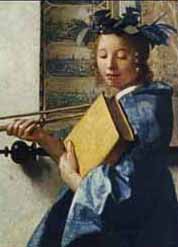
Clio
Encyclopedia

Greek mythology
Greek mythology is the body of myths and legends belonging to the ancient Greeks, concerning their gods and heroes, the nature of the world, and the origins and significance of their own cult and ritual practices. They were a part of religion in ancient Greece...
, Clio (icon; ) or Kleio, is the muse
Muse
The Muses in Greek mythology, poetry, and literature, are the goddesses who inspire the creation of literature and the arts. They were considered the source of the knowledge, related orally for centuries in the ancient culture, that was contained in poetic lyrics and myths...
of history. Like all the muses, she is a daughter of Zeus
Zeus
In the ancient Greek religion, Zeus was the "Father of Gods and men" who ruled the Olympians of Mount Olympus as a father ruled the family. He was the god of sky and thunder in Greek mythology. His Roman counterpart is Jupiter and his Etruscan counterpart is Tinia.Zeus was the child of Cronus...
and Mnemosyne
Mnemosyne
Mnemosyne , source of the word mnemonic, was the personification of memory in Greek mythology. This titaness was the daughter of Gaia and Uranus and the mother of the nine Muses by Zeus:* Calliope * Clio * Erato...
. She had one son, Hyacinth
Hyacinth (mythology)
Hyacinth or Hyacinthus is a divine hero from Greek mythology. His cult at Amyclae, southwest of Sparta, where his tumulus was located— in classical times at the feet of Apollo's statue in the sanctuary that had been built round the burial mound— dates from the Mycenaean era...
, with one of several kings, in various myths - with Pierus
Pierus
Pierus , in Greek mythology, is a name attributed to two individuals.*Pierus, the eponym of Pieria, son of Makednos and father by Antiope or Euippe of the of Pierides, nine maidens who wanted to outshine the Muses...
, King of Macedon
Macedon
Macedonia or Macedon was an ancient kingdom, centered in the northeastern part of the Greek peninsula, bordered by Epirus to the west, Paeonia to the north, the region of Thrace to the east and Thessaly to the south....
, or with king Oebalus
Oebalus
In Greek mythology, King Oebalus or Oibalos of Sparta, son of Cynortas, was the second husband of Gorgophone. With her, he fathered Tyndareus, Icarius and Hippocoon , as well as a daughter, Arene, who married her half-brother Aphareus...
of Sparta
Sparta
Sparta or Lacedaemon, was a prominent city-state in ancient Greece, situated on the banks of the River Eurotas in Laconia, in south-eastern Peloponnese. It emerged as a political entity around the 10th century BC, when the invading Dorians subjugated the local, non-Dorian population. From c...
, or with king Amyclas
Amyclas
In Greek mythology, Amyclas refers to three individuals:*Amyclas was the son of Lacedemon and Sparta, and he was the brother of Eurydice . According to Pseudo-Apollodorus, he was the father of Hyacinth and Cynortas; according to Pausanias, he was also the father of Laodamia or Leaneira, wife of...
, progenitor of the people of Amyclae, dwellers about Sparta. Some sources say she was also the mother of Hymenaios
Hymenaios
In Greek mythology, Hymen was a god of marriage ceremonies, inspiring feasts and song. Related to the god's name, a hymenaios is a genre of Greek lyric poetry sung during the procession of the bride to the groom's house in which the god is addressed, in contrast to the Epithalamium, which was sung...
.
She is often represented with a parchment scroll or a set of tablets and is also known as the Proclaimer. The name is from the root κλέω/κλείω, meaning "recount" or "make famous".
'Clio' represents history
History
History is the discovery, collection, organization, and presentation of information about past events. History can also mean the period of time after writing was invented. Scholars who write about history are called historians...
in some coined words: cliometrics
Cliometrics
Cliometrics, sometimes called new economic history, or econometric history, is the systematic application of economic theory, econometric techniques, and other formal or mathematical methods to the study of history . It is a quantitative approach to economic history...
, cliodynamics
Cliodynamics
thumb|Clio—detail from [[The Art of Painting|The Allegory of Painting]] by [[Johannes Vermeer]]Cliodynamics is a new multidisciplinary area of research focused at mathematical modeling of historical dynamics.-Origins:The term was originally coined by Peter...
.

